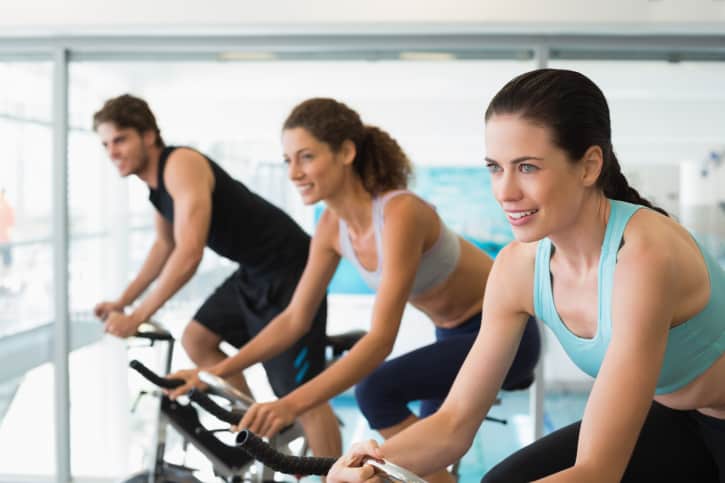
Are you new to your gym and the indoor cycling (also known as “spinning”) scene? Well, have no fear! Indoor cycling is a great workout all year round for any level, expert cyclists and newbies alike. Nevertheless here are 3 tips for those just starting a new spin class.
1. Sit Sit Sit!!
No matter what we do, the bike seat will never feel like a recliner! Learning to sit correctly will make a huge difference in how you feel during and after your class. Backside comfort is the biggest issue for new indoor cyclists—men or women!
Maintain a neutral spine (don’t round those shoulders!), lifting your chest and not slouching will help to keep the pressure off of your more tender parts. Make sure to sit towards the back edge of the saddle, without “tucking your tail.”
Ultimately, use bike shorts—yes, those cute, padded, diaper-like shorts, are a great way to keep friction at bay! Avoid gel seat covers and towels, as they can actually cause more shifting and friction on the seat…not a great way to spend a 45-60 minute ride!
2. How high (or low) is your seat?
Most of us can feel when the seat is set too high. Many cyclists ride with the seat set too low because it’s harder to “feel” when the seat is set incorrectly low. Finding the right seat height will make you more comfortable in the saddle, help to generate more power with each pedal stroke (more calories burned!), but most importantly, will help to reduce low back, hip, and knee injuries.
We tell our riders to set their seats at “hip height.” This is a great start, but it needs fine-tuning. As a rider, you should start with hip height, but then get on and pedal. If you hyperextend your knee, your hips move excessively side to side or have to point your toes to reach the pedal on the downstroke, you need to bring that seat down a bit!
The fore/aft adjustment should position the knee of your lead leg directly over the ball of your foot (the widest part of the foot). Make sure you can still see your toes in that position! Remember that saddle height affects the fore/aft positioning of the seat, so when you change one adjustment you must re-check the other.
Handlebar set-up is based purely on back comfort. Although, you never want to have to reach too far for the handlebars or smack your knees on them during the upstroke of the pedal. Make sure you can place your whole hand on the handlebars while seated—not just your fingertips. Beyond that, you can set it up like a beach cruiser or a time trial bike, up to you!
3. How fast (or slow) can you go?
Power is the key to our cycling universe! Speed without resistance is not powerful, or beneficial to building your cardiovascular capacity. Pedaling too fast can cause strain on the ligaments and tendons of the hips and knees. At extremely high speeds, we stop engaging the quadriceps muscles, which act to stabilize the joints. Without that stabilization, we put those knees and hips in a position that makes them vulnerable to injury.
When you have enough resistance, your hips will not bounce! If you cheat your resistance, you won’t get a great workout. Pedaling without resistance, regardless of speed, isn’t work. A good cycling class is work—no doubt about it! You won’t burn 1200 calories in a 45-minute class—we’ve all seen those outrageous claims! But, you can burn up to 600 calories (without resistance you’re more likely to burn 100, you could vacuum your living room and burn those calories!)
Your maximum speed should be about 110RPM. The ideal speed/RPM for great power production is 60-90RPM. Remember, that power correlates directly to calorie burn!
Conversely, adding resistance is great, but if you don’t power through that added gear, you’re getting nowhere! Going too slow achieves less because you have to push really hard with your legs, but in reality, your power output is dropping as well as your heart rate. Learn to maintain a faster and more efficient pace in class by staying at 60RPM+ on hills.
Your minimum speed should be 50RPM. Work to find a resistance level that is challenging for your legs AND your lungs (not just your legs).
Remember, the instructors are there to help you! If you have questions about your cycling technique or bike set up, ASK!!
Get your own personalized plan!By Annie Farley, MS, CPT; Spinning Certified Star 3 Instructor & Group Exercise Instructor at Elite Sports Club-Mequon